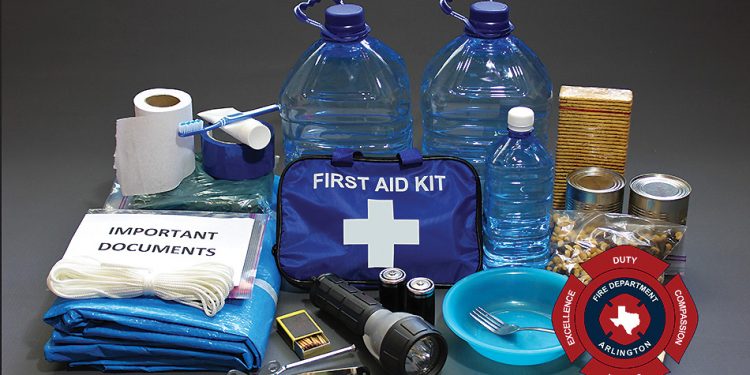Arlington residents can take steps to be better prepared in the event of an emergency by assembling a disaster supply kit containing basic items that their household may need. This includes having enough water, food, cash and other supplies for each person in the household that would last for at least three days.
“Everyone needs a kit. During a widespread emergency, help may take several days to arrive. Families should be prepared to survive for up to three days before help arrives,” says Shawna Lemley, Emergency Management Planner for the City of Arlington’s Office of Emergency Management. “[You should] plan now, because you never know when a disaster will happen.”
When assembling your kit, it is important to discuss emergencies, your family’s plan, and the kits with every member of the family so that everyone understands where the kits are and what they are for, Lemley says.
Residents can make sure their emergency kit is stocked appropriately with the items on the checklist below. In addition to the basic supplies, residents should consider what unique needs their family might have, such as supplies for pets, infants or seniors.
A basic emergency supply kit could include the following recommended items:
- Water – at least one gallon per person, per day
- Non-perishable food (dried fruit, peanut butter or energy bars)
- Extra cell phone battery or charger
- Battery-powered radio that can receive NOAA Weather Radio alerts
- Flashlight and extra batteries
- First aid kit
- Dust mask, plastic sheeting and duct tape to shelter-in-place
- Moist towelettes, garbage bags and plastic ties
- Toothbrush, toothpaste, soap
- Non-sparking wrench or pliers to turn off utilities
- Manual can opener (if kit contains canned food)
- Prescription medications and glasses
- Whistle to signal for help
- Local maps
This list of emergency supply kit items is only a starting point. It is important that individuals review this list and consider the unique needs of their family, including pets, for items to include. Individuals should also consider having at least two emergency supply kits, one full kit at home and smaller portable kits in their workplace, vehicle or other places they spend time.
Additional items to consider adding to an emergency supply kit:
- Prescription medications and glasses
- Non-prescription medications you take routinely
- Infant formula, bottles, diapers, wipes and diaper rash cream
- Pet food, water and supplies for your pet
- Important family documents in a portable waterproof container
- Cash or traveler’s checks
- Sleeping bag or warm blanket for each person.
- Complete change of clothing, including a long-sleeved shirt, long pants and sturdy shoes
- Fire Extinguisher
- Matches in a waterproof container
- Feminine supplies, personal hygiene items and hand sanitizer
- Mess kits, paper cups, plates and disposable utensils, paper towels
- Paper and pencil
- Books, games, puzzles or other activities for children
Maintaining Your Kit
After assembling your kit remember to:
- Keep canned food in a cool, dry place
- Store boxed food in tightly closed plastic or metal containers
- Replace expired items as needed
- Reassess your kit during daylight savings twice per year and update your kit as your family’s needs change
Kit Storage Locations
Since you do not know where you will be when an emergency occurs, prepare supplies for home, work and cars.
Home: Have the kit ready in case you have to leave your home quickly. Make sure all family members know where the kit is kept.
Work: Be prepared to shelter at work for at least 24 hours. Your work kit should include food, water and other necessities, as well as comfortable walking shoes, stored in a “grab and go” case.
Car: In case you are stranded, keep a kit of emergency supplies in your car. Update your car kit between each season based on seasonal hazards.
For more: arlingtontx.gov/preparedness

















